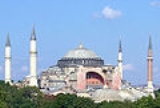
Conversion of non-Muslim places of worship into mosques
Encyclopedia

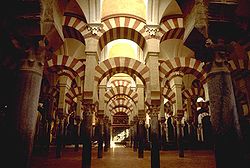
Muhammad
Muhammad |ligature]] at U+FDF4 ;Arabic pronunciation varies regionally; the first vowel ranges from ~~; the second and the last vowel: ~~~. There are dialects which have no stress. In Egypt, it is pronounced not in religious contexts...
and continued during subsequent Islam
Islam
Islam . The most common are and . : Arabic pronunciation varies regionally. The first vowel ranges from ~~. The second vowel ranges from ~~~...
ic conquests and under the Muslim
Muslim
A Muslim, also spelled Moslem, is an adherent of Islam, a monotheistic, Abrahamic religion based on the Quran, which Muslims consider the verbatim word of God as revealed to prophet Muhammad. "Muslim" is the Arabic term for "submitter" .Muslims believe that God is one and incomparable...
rule. As a result, numerous Hindu temples, churches, synagogue
Synagogue
A synagogue is a Jewish house of prayer. This use of the Greek term synagogue originates in the Septuagint where it sometimes translates the Hebrew word for assembly, kahal...
s, the Parthenon
Parthenon
The Parthenon is a temple on the Athenian Acropolis, Greece, dedicated to the Greek goddess Athena, whom the people of Athens considered their virgin patron. Its construction began in 447 BC when the Athenian Empire was at the height of its power. It was completed in 438 BC, although...
and Zoroastrian
Zoroastrianism
Zoroastrianism is a religion and philosophy based on the teachings of prophet Zoroaster and was formerly among the world's largest religions. It was probably founded some time before the 6th century BCE in Greater Iran.In Zoroastrianism, the Creator Ahura Mazda is all good, and no evil...
temples became mosque
Mosque
A mosque is a place of worship for followers of Islam. The word is likely to have entered the English language through French , from Portuguese , from Spanish , and from Berber , ultimately originating in — . The Arabic word masjid literally means a place of prostration...
s.
The Mosque
A mosque is a place of worshipPlace of worship
A place of worship or house of worship is an establishment or her location where a group of people comes to perform acts of religious study, honor, or devotion. The form and function of religious architecture has evolved over thousands of years for both changing beliefs and architectural style...
for followers of Islam
Islam
Islam . The most common are and . : Arabic pronunciation varies regionally. The first vowel ranges from ~~. The second vowel ranges from ~~~...
, which literally means a place of prostration
Prostration
Prostration is the placement of the body in a reverentially or submissively prone position. Major world religions employ prostration either as a means of embodying reverence for a noble person, persons or doctrine, or as an act of submissiveness to a supreme being or beings...
. The word "mosque" in English
English language
English is a West Germanic language that arose in the Anglo-Saxon kingdoms of England and spread into what was to become south-east Scotland under the influence of the Anglian medieval kingdom of Northumbria...
refers to all types of buildings dedicated for Islamic worship although there is a distinction in Arabic between the smaller, masjids dedicated for daily five prayers and the larger masajid where the daily five prayers and the Friday congregation sermons are held (مسجد جامع, masjid jāmi‘), which is attended by more people and play more roles such as teaching Qur'an.
It is related of the Arab
Arab
Arab people, also known as Arabs , are a panethnicity primarily living in the Arab world, which is located in Western Asia and North Africa. They are identified as such on one or more of genealogical, linguistic, or cultural grounds, with tribal affiliations, and intra-tribal relationships playing...
commander Amr ibn al-As that he performed the salat
Salat
Salah is the practice of formal prayer in Islam. Its importance for Muslims is indicated by its status as one of the Five Pillars of Sunni Islam, of the Ten Practices of the Religion of Twelver Islam and of the 7 pillars of Musta'lī Ismailis...
(prayer) in a church and Zayd ibn Ali
Zayd ibn Ali
Zayd ibn ‘Alī was the grandson of Husayn ibn Alī, the grandson of Muhammad. Zayd was born in Medina in 695. His father was the Shī‘ah Imam ‘Alī ibn Husayn "Zayn al-Abidīn"...
says regarding churches and synagogues, "Perform thy salat
Salat
Salah is the practice of formal prayer in Islam. Its importance for Muslims is indicated by its status as one of the Five Pillars of Sunni Islam, of the Ten Practices of the Religion of Twelver Islam and of the 7 pillars of Musta'lī Ismailis...
in them; it will not harm thee", meaning that churches and synagogues can safely be performed as acceptable for salaat mosque
Mosque
A mosque is a place of worship for followers of Islam. The word is likely to have entered the English language through French , from Portuguese , from Spanish , and from Berber , ultimately originating in — . The Arabic word masjid literally means a place of prostration...
s.
Ka'aba
In Islamic tradition, the Ka'ba was built by Ibrahim (Abraham) and his son. Others argue that the Ka'aba, located in MeccaMecca
Mecca is a city in the Hijaz and the capital of Makkah province in Saudi Arabia. The city is located inland from Jeddah in a narrow valley at a height of above sea level...
, had always been a non-Muslim sanctuary. But by the time of Muhammad
Muhammad
Muhammad |ligature]] at U+FDF4 ;Arabic pronunciation varies regionally; the first vowel ranges from ~~; the second and the last vowel: ~~~. There are dialects which have no stress. In Egypt, it is pronounced not in religious contexts...
, the site had long been a pagan temple, which Muhammad converted into a mosque
Mosque
A mosque is a place of worship for followers of Islam. The word is likely to have entered the English language through French , from Portuguese , from Spanish , and from Berber , ultimately originating in — . The Arabic word masjid literally means a place of prostration...
in January 630.
Before the rise of Islam the Ka'aba was revered as a sacred sanctuary and was a site of pilgrimage.". At the time of Muhammad
Muhammad
Muhammad |ligature]] at U+FDF4 ;Arabic pronunciation varies regionally; the first vowel ranges from ~~; the second and the last vowel: ~~~. There are dialects which have no stress. In Egypt, it is pronounced not in religious contexts...
(CE 570–632), his tribe the Quraysh was in charge of the Kaaba, which was at that time a shrine containing hundreds of idols representing Arabian tribal gods
Arabian mythology
Arabian mythology comprises the ancient, pre-Islamic beliefs of the Arabs. Prior to Islam the Kaaba of Mecca was covered in symbols representing the myriad demons, djinn, demigods, or simply tribal gods and other assorted deities which represented the polytheistic culture of pre-Islamic Arabia...
and other religious figures. Muhammad earned the enmity of his tribe by claiming the shrine for the new religion of Islam that he preached. He wanted the Kaaba to be dedicated to the worship of the one God alone, and all the idols were evicted. The Black Stone (al-Hajar-ul-Aswad
Black Stone
The Black Stone is the eastern cornerstone of the Kaaba, the ancient stone building towards which Muslims pray, in the center of the Grand Mosque in Mecca, Saudi Arabia. It is revered by Muslims as an Islamic relic, which according to Muslim tradition dates back to the time of Adam and Eve.The...
), still present at the Kaaba
Kaaba
The Kaaba is a cuboid-shaped building in Mecca, Saudi Arabia, and is the most sacred site in Islam. The Qur'an states that the Kaaba was constructed by Abraham, or Ibraheem, in Arabic, and his son Ishmael, or Ismaeel, as said in Arabic, after he had settled in Arabia. The building has a mosque...
was a special object of veneration at the site. According to tradition the text of seven especially honored poems
Mu'allaqat
The Mu‘allaqāt is the title of a group of seven long Arabic poems or qasida that have come down from the time before Islam. Each is considered the best work of these pre-Islamic poets...
were suspended around the Ka'aba, but there is no contemporary evidence for this claim. Martin Lings' biography of Muhammad claims that even an image of the Virgin Mary had been displayed in the pagan shrine.
According to Islam
Islam
Islam . The most common are and . : Arabic pronunciation varies regionally. The first vowel ranges from ~~. The second vowel ranges from ~~~...
, Muhammad's actions were not strictly a conversion but rather a restoration of the mosque established on that site by Abraham
Abraham
Abraham , whose birth name was Abram, is the eponym of the Abrahamic religions, among which are Judaism, Christianity and Islam...
, who is considered to be a prophet in Islam. The Ka'aba thus became known as the Masjid al-Haram
Masjid al-Haram
Al-Masjid al-Ḥarām is the largest mosque in the world. Located in the city of Mecca, it surrounds the Kaaba, the place which Muslims worldwide turn towards while performing daily prayers and is Islam's holiest place...
, or Sacred Mosque, the holiest site in Islam.
Biblical holy sites
Mosques were regularly established on the places of Jewish or Christian sanctuaries associated with BiblicalBible
The Bible refers to any one of the collections of the primary religious texts of Judaism and Christianity. There is no common version of the Bible, as the individual books , their contents and their order vary among denominations...
personalities who were also recognized by Islam. This practice was particularly common in Palestine. The Caliph Umar
Umar
`Umar ibn al-Khattāb c. 2 November , was a leading companion and adviser to the Islamic prophet Muhammad who later became the second Muslim Caliph after Muhammad's death....
initially built a small prayer house, which laid the foundation for the later construction of the Al-Aqsa mosque
Al-Aqsa Mosque
Al-Aqsa Mosque also known as al-Aqsa, is the third holiest site in Sunni Islam and is located in the Old City of Jerusalem...
on the Temple Mount
Temple Mount
The Temple Mount, known in Hebrew as , and in Arabic as the Haram Ash-Sharif , is one of the most important religious sites in the Old City of Jerusalem. It has been used as a religious site for thousands of years...
, the most sacred site in Judaism
Judaism
Judaism ) is the "religion, philosophy, and way of life" of the Jewish people...
, possibly by the Ummayyads Al-Aqsa mosque#Construction by the Umayyads. The Dome of the Rock
Dome of the Rock
The Dome of the Rock is a shrine located on the Temple Mount in the Old City of Jerusalem. The structure has been refurbished many times since its initial completion in 691 CE at the order of Umayyad Caliph Abd al-Malik...
, another Muslim mosque, was also built on the Temple Mount which was an abandoned and disused area. Upon the capture of Jerusalem, it is commonly reported that Umar refused to pray in the Church of the Holy Sepulchre
Church of the Holy Sepulchre
The Church of the Holy Sepulchre, also called the Church of the Resurrection by Eastern Christians, is a church within the walled Old City of Jerusalem. It is a few steps away from the Muristan....
. for fear that later Muslims would then convert it into a mosque in spite of a treaty guaranteeing its safety.
The mosque of Job
Job (Biblical figure)
Job is the central character of the Book of Job in the Hebrew Bible. Job is listed as a prophet of God in the Qur'an.- Book of Job :The Book of Job begins with an introduction to Job's character — he is described as a blessed man who lives righteously...
in Ash Shaykh Sa'd, Syria
Syria
Syria , officially the Syrian Arab Republic , is a country in Western Asia, bordering Lebanon and the Mediterranean Sea to the West, Turkey to the north, Iraq to the east, Jordan to the south, and Israel to the southwest....
, was previously a church of Job. The Herodian shrine of Cave of the Patriarchs
Cave of the Patriarchs
The Cave of the Patriarchs or the Cave of Machpelah , is known by Muslims as the Sanctuary of Abraham or Ibrahimi Mosque ....
, the second most holy site in Judaism, was converted into a church during the Crusades before being turned into a mosque in 1266 and henceforth banned to Jews and Christians. Part of it was restored as a synagogue after 1967 by Israel.
In October 2000, during the Al-Aqsa intifada
Al-Aqsa Intifada
The Second Intifada, also known as the Al-Aqsa Intifada and the Oslo War, was the second Palestinian uprising, a period of intensified Palestinian-Israeli violence, which began in late September 2000...
, the tomb
Joseph's Tomb
Joseph's Tomb is a funerary monument located at the eastern entrance to the valley that separates Mounts Gerizim and Ebal, 325 yards northwest of Jacob's Well, on the outskirts of the West Bank city of Nablus, near Tell Balāṭa, the site of biblical Shechem...
of the Hebrew
Hebrews
Hebrews is an ethnonym used in the Hebrew Bible...
patriarch Joseph
Joseph (Hebrew Bible)
Joseph is an important character in the Hebrew bible, where he connects the story of Abraham, Isaac and Jacob in Canaan to the subsequent story of the liberation of the Israelites from slavery in Egypt....
, and the yeshiva
Yeshiva
Yeshiva is a Jewish educational institution that focuses on the study of traditional religious texts, primarily the Talmud and Torah study. Study is usually done through daily shiurim and in study pairs called chavrutas...
inside Od Yosef Chai, located in Nablus
Nablus
Nablus is a Palestinian city in the northern West Bank, approximately north of Jerusalem, with a population of 126,132. Located in a strategic position between Mount Ebal and Mount Gerizim, it is the capital of the Nablus Governorate and a Palestinian commercial and cultural center.Founded by the...
, was damaged by a Palestinian mob. During Palestinian Authority-organised repairs, the dome was painted green. It was repainted white again following international protests and objections.
Hindu, Jain and Buddhist temples
The destruction of HinduHindu
Hindu refers to an identity associated with the philosophical, religious and cultural systems that are indigenous to the Indian subcontinent. As used in the Constitution of India, the word "Hindu" is also attributed to all persons professing any Indian religion...
temples in India
India
India , officially the Republic of India , is a country in South Asia. It is the seventh-largest country by geographical area, the second-most populous country with over 1.2 billion people, and the most populous democracy in the world...
during the Islamic conquest of India occurred from the beginning of Muslim conquest until the end the Mughal Empire
Mughal Empire
The Mughal Empire , or Mogul Empire in traditional English usage, was an imperial power from the Indian Subcontinent. The Mughal emperors were descendants of the Timurids...
throughout the Indian subcontinent
Indian subcontinent
The Indian subcontinent, also Indian Subcontinent, Indo-Pak Subcontinent or South Asian Subcontinent is a region of the Asian continent on the Indian tectonic plate from the Hindu Kush or Hindu Koh, Himalayas and including the Kuen Lun and Karakoram ranges, forming a land mass which extends...
.
In his book "Hindu Temples - What Happened to Them
Hindu Temples - What Happened to Them
Hindu Temples – What Happened to Them is a two-volume book by Sita Ram Goel, Arun Shourie, Harsh Narain, Jay Dubashi and Ram Swarup. The first volume was published in spring 1990....
", Sita Ram Goel included a list of 2000 mosques that it is claimed were built on Hindu temples. The second volume of the book excerpts from medieval histories and chronicles and from inscriptions concerning the destruction of Hindu, Jain and Buddhist temples.
In Indonesia
Indonesia
Indonesia , officially the Republic of Indonesia , is a country in Southeast Asia and Oceania. Indonesia is an archipelago comprising approximately 13,000 islands. It has 33 provinces with over 238 million people, and is the world's fourth most populous country. Indonesia is a republic, with an...
, where popular conversion from Hinduism to Islam was more voluntary and peaceful, it is believed that the minaret
Minaret
A minaret مناره , sometimes مئذنه) is a distinctive architectural feature of Islamic mosques, generally a tall spire with an onion-shaped or conical crown, usually either free standing or taller than any associated support structure. The basic form of a minaret includes a base, shaft, and gallery....
of the Menara Kudus Mosque
Menara Kudus Mosque
The Menara Kudus Mosque or Al-Manar Mosque is located in Kudus in the Indonesian province of Central Java. Dating from 1549, it is one of the oldest mosques in Indonesia, built at the time of Islam's spread through Java...
, in Java, was originally part of a Hindu temple.
Ram Janmabhoomi
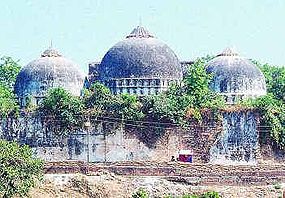
Ram Janmabhoomi
Ram Janmabhoomi is the "Birthplace of Lord Rama."Lord Rama is a major God in Hindu theology and the Hindu religion where He is described as an Avatar of Lord Vishnu in Hinduism. The exact location of Lord Rama's birth as stated in holy Ramayan as being in the city of Ayoudhya in Uttar Pardesh...
refers to a tract of land in the North Indian city of Ayodhya which is claimed to be the birthplace of Lord Rama
Rama
Rama or full name Ramachandra is considered to be the seventh avatar of Vishnu in Hinduism, and a king of Ayodhya in ancient Indian...
. Archeological Survey of India (ASI), after conducting excavations at the site reported that prior to 1528, filed a report that stated that a temple stood at this site before the arrival of Mughals
Mughal (tribe)
The term Mughal is simply a Turkic word and many groups in India, Pakistan, Afghanistan, and Bangladesh use the term Mughal to describe themselves...
who constructed Babri Mosque
Babri Mosque
The Babri Mosque , was a mosque in Ayodhya, a city in the Faizabad district of Uttar Pradesh, on Ramkot Hill . It was destroyed in 1992 when a political rally developed into a riot involving 150,000 people, despite a commitment to the Indian Supreme Court by the rally organisers that the mosque...
at its present site. Critics of the report claim that the "presence of animal bones throughout as well as of the use of 'surkhi' and lime mortar" that was found by ASI are all characteristic of Muslim presence, which they claim "rule out the possibility of a Hindu temple having been there beneath the mosque".
From 1528 to 1992 this was the site of the Babri Mosque
Babri Mosque
The Babri Mosque , was a mosque in Ayodhya, a city in the Faizabad district of Uttar Pradesh, on Ramkot Hill . It was destroyed in 1992 when a political rally developed into a riot involving 150,000 people, despite a commitment to the Indian Supreme Court by the rally organisers that the mosque...
. The mosque was razed in December 6, 1992 by a mob of some 150,000 nationalist Hindus
Hindu nationalism
Hindu nationalism has been collectively referred to as the expressions of social and political thought, based on the native spiritual and cultural traditions of historical India...
supported by the Bharatiya Janata Party
Bharatiya Janata Party
The Bharatiya Janata Party ,; translation: Indian People's Party) is one of the two major political parties in India, the other being the Indian National Congress. Established in 1980, it is India's second largest political party in terms of representation in the parliament...
(BJP), Rashtriya Swayamsevak Sangh
Rashtriya Swayamsevak Sangh
Rashtriya Swayamsevak Sangh or National Patriotic Organization), also known the Sangh, is a right-wing Hindu nationalist, paramilitary, volunteer, and allegedly militant organization for Hindu males in India...
(RSS) and the Vishwa Hindu Parishad (VHP), after a political rally developed into a riot despite a commitment to the Indian Supreme Court
Supreme Court of India
The Supreme Court of India is the highest judicial forum and final court of appeal as established by Part V, Chapter IV of the Constitution of India...
by the rally organisers that the mosque would not be harmed.
The Sangh Parivaar, along with VHP and the main Indian opposition party, the Bharatiya Janata Party, sought to erect a temple dedicated to Lord Rama at this site. Nobel Laureate novelist V. S. Naipaul
V. S. Naipaul
Sir Vidiadhar Surajprasad "V. S." Naipaul, TC is a Nobel prize-winning Indo-Trinidadian-British writer who is known for his novels focusing on the legacy of the British Empire's colonialism...
has praised Hindu nationalists for "reclaiming India's Hindu heritage". Naipaul added that the destruction of Babri structure was an act of historical balancing and the reclaiming of the Ramjanmabhoomi was a "welcome sign that Hindu pride was re-asserting itself".
The 1986 edition of the Encyclopædia Britannica
Encyclopædia Britannica
The Encyclopædia Britannica , published by Encyclopædia Britannica, Inc., is a general knowledge English-language encyclopaedia that is available in print, as a DVD, and on the Internet. It is written and continuously updated by about 100 full-time editors and more than 4,000 expert...
stated that "Rama’s birthplace is marked by a mosque, erected by the Moghul emperor Babar in 1528 on the site claimed of an earlier temple".
Archaeological excavations at the site by the Archeological Survey of India reported the existence of a 10th century temple. " The report stated that scientific dating indicated human activity at the site as far back to the 17th century BC.
On 30 September 2010, Allahabad High Court
Allahabad High Court
The Allahabad High Court or the High Court of Judicature at Allahabad is a high court having jurisdiction over the Indian state of Uttar Pradesh since 1950...
ruled that the 2.7 acres disputed land in Ayodhya, on which the Babri Masjid stood before it was demolished on December 6, 1992, will be divided into three parts: the site of the Ramlala idol to Lord Ram, Nirmohi Akhara
Nirmohi Akhara
Nirmohi Akhara is a Hindu religious denomination. It is one of the 14 akharas recognized by the Akhil Bharatiya Akhara Parishad and belongs to the Vaishnava sampradaya. It is headed by Mahant Bhaskar Das.-History:...
gets Sita Rasoi and Ram Chabutara, Sunni Wakf Board gets a third. The court also agreed with the ASI report, and considered the mosque to have been predated by a massive Hindu religious structure which was demolished by Babur. This decision paved the way for reconstruction of a temple dedicated to Lord Rama.
Krishna Janmabhoomi (Mathura)
The great temple of Keshava Rai at Mathura was built by Bir Singh Deo Bundela during Jahangir’s time at a cost of thirty-three lakhs of rupees. The Dehra of Keshava Rai was one of the most magnificent temples ever built in India and enjoyed veneration of the Hindus throughout the land. Prince Dara Shukoh, who was looked upon by the masses as the future Emperor, had presented a carved stone railing to the temple which was installed in front of the deity at some distance; the devotees stood outside this railing to have ‘darshan’ of Keshava Rai. The railing was removed on Aurangzeb’s orders in October 1666.The Dehra of Keshava Rai was demolished in the month of Ramzan, 1080 A.H. (13 January – 11 February 1670) by Aurangzeb’s order. “In a short time, by the great exertion of the officers, the destruction of this strong foundation of infidelity was accomplished and on its site a lofty mosque was built at the expenditure of a large sum”. To the author of Maasir-i-‘Alamigiri, the accomplishment of this “seemingly impossible work was an “instance of the strength of the Emperor’s faith”.
Somnath Temple
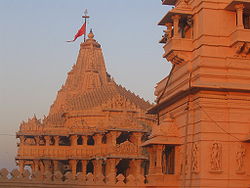
Soon the temple regained its old glory and wealth, the descriptions of which were carried to the Middle East. In particular, the accounts of the Arab Al Biruni impressed Mahmud of Ghazni. In 1025 CE, Ghazni destroyed and looted the temple, killing over 50,000 people who tried to defend it.The defenders included the 90-year-old clan leader Ghogha Rana. Ghazni personally broke the gilded lingam to pieces. He took them back to his homeland and placed them in the steps leading to the newly built Jamiah Masjid, so that they would be stepped upon by those going to the mosque to pray.
Work on the fourth temple was started immediately by the Paramara King Bhoj of Malwa and the Solanki king Bhima of Patan and the temple was ready by 1042 CE. This temple was destroyed in 1300 CE. At that time Allaudin Khilji occupied the throne of Delhi and he sent his general, Alaf Khan, to pillage Somnath. The fifth temple was built by King Mahipala of the Chudasama dynasty.
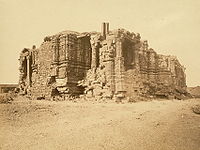
In 1783 CE queen Ahilyabhai Holkar built the sixth temple at an adjacent site. The temple still stands and worship is carried out there.
After independence, Sardar Vallabhbhai Patel pledged on November 13, 1947, that the seventh temple would be reconstructed. According to prescribed Hindu rituals, pledges are made by taking holy water in one’s fist. Leaders like Morarji Desai, Dr. Rajendra Prasad (the first President) and Kanhaiyalal Munshi joined in and the work was entrusted to the Sompura Shilpakars, whose ancestors rebuilt each new temple through the ages. The mosque built by Aurangazeb was not destroyed but carefully relocated. In 1951 Dr. Rajendra Prasad performed the consecration ceremony with the words “The Somnath Temple signifies that the power of creation is always greater than the power of destruction.”
The temple construction was completed on December 1, 1995, long after the demise of Sardar Patel. The then President of India, Dr. Shankar Dayal Sharma, dedicated it to the nation.
Kashi Viswanath (Banaras)
Kashi is one of the most sacred sites in Hindu India and the worship of Shiva as Vishveshvara goes back to ancient times. According to the Puranas, every step taken in Kashi Kshetra has the sanctity of making a pilgrimage to a tirtha. Lord Vishvanatha is regarded as the protector of Kashi and the belief is that one earns great religious merit by having a vision of the deity after having bathed in the Ganges.The temple was demolished several times by Muslim invaders, and was reconstructed again and again by Hindu kings.After destruction of the original temple on the orders of Mughal emperor Aurangzeb's orders, a mosque was built which still stands.Taj Mahal Mosque (Agra)
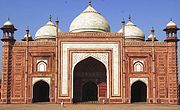
In the paper titled "The question of the Taj Mahal", authors P. S. Bhat and A. L. Athawale have questioned this widely held belief. The Taj Mahal mosque adjacent to the main mausoleum is identical to another building facing eastwards leading to the speculation that the original purpose of the Taj Mahal mosque could have been something else. The authors also raise doubts about the origin of the Mogul architecture. They claim that it is possible for the bulbous dome architecture to previously exist in India prior to the Mogul era as is seen in the temples of Muktagiri and Sonagarh. This also raises interesting questions about the possible pre-existence of other buildings containing elements of bulbous domes such as Babri Masjid and Humayun's Tomb prior to the Mogul era. It will then imply that the previously existing dome shaped buildings(temples) were merely converted to Mosques and Tombs by removing the idols and doing Quranic inscriptions and not built by the Moguls as is widely believed.
Other references
An inscription at the Quwwat Al-Islam Mosque in Delhi states:This Jamii Masjid built in the months of the year 587 (hijri) by the Amir, the great, the glorious commander of the Army, Qutb-ud-daula wad-din, the Amir-ul-umara Aibeg, the slave of the Sultan, may God strengthen his helpers! The materials of 27 idol temples, on each of which 2,000,000 Deliwal coins had been spent were used in the (construction of) this mosque. However as the inscription depicts, the mosque was built from the material remnants of Hindu temples which was destroyed by muslims.
During the reign of Aurangzeb
Aurangzeb
Abul Muzaffar Muhy-ud-Din Muhammad Aurangzeb Alamgir , more commonly known as Aurangzeb or by his chosen imperial title Alamgir , was the sixth Mughal Emperor of India, whose reign lasted from 1658 until his death in 1707.Badshah Aurangzeb, having ruled most of the Indian subcontinent for nearly...
, tens of thousands of temples were desecrated: their facades and interiors were defaced and their murtis (divine images) looted. In many cases, temples were destroyed entirely; in numerous instances mosques were built on their foundations, sometimes using the same stones. Among the temples Aurangzeb destroyed were two that are most sacred to Hindus, in Varanasi and Mathura. In both cases, he had large mosques built on the sites.
Alberuni in his India writes about the famous temple of Multan:
A famous idol of theirs was that of Multan, dedicated to the sun, .. When Muhammad Ibn Alkasim Ibn Almunabbih, conquered Multan, he inquired how the town had become so very flourishing and so many treasures had there been accumulated, and then he found out that this idol was the cause, for there came pilgrims from all sides to visit it. Therefore he thought to build a mosque at the same place where the temple once stood. When then the Karmatians occupied Multan, Jalam Ibn Shaiban, the usurper, broke the idol into pieces and killed its priests. .. When afterwards the blessed Prince Mahmud swept away their rule from those countries, he made again the old mosque the place of the Friday-worship.
An inscription of 1462 A.D.at Jami Masjid at Malan, in Banaskantha District of Gujarat states:
The Jami Masjid was built by Khan-I-Azam Ulugh Khan, who suppressed the wretched infidels. He eradicated the idolatrous houses and mine of infidelity, along with the idols with the edge of the sword, and made ready this edifice. He made its walls and doors out of the idols; the back of every stone became the place for prostration of the believer.
Mughal Emperor Jahangir
Jahangir
Jahangir was the ruler of the Mughal Empire from 1605 until his death. The name Jahangir is from Persian جهانگیر,meaning "Conqueror of the World"...
wrote in his Tujuk-i-Jahangiri:
"I am here led to relate that at the city of Banaras a temple had been erected by Rajah Maun Sing, which cost him the sum of nearly thirty-six laks of five methkaly ashrefies. ...I made it my plea for throwing down the temple which was the scene of this imposture; and on the spot, with the very same materials, I erected the great mosque, because the very name of Islam was proscribed at Banaras, and with God’s blessing it is my design, if I live, to fill it full with true believers".
Zoroastrian temples
After the Islamic conquest of PersiaIslamic conquest of Persia
The Muslim conquest of Persia led to the end of the Sassanid Empire in 644, the fall of Sassanid dynasty in 651 and the eventual decline of the Zoroastrian religion in Persia...
, Zoroastrian
Zoroastrianism
Zoroastrianism is a religion and philosophy based on the teachings of prophet Zoroaster and was formerly among the world's largest religions. It was probably founded some time before the 6th century BCE in Greater Iran.In Zoroastrianism, the Creator Ahura Mazda is all good, and no evil...
fire temples, with their four axial arch openings, were usually turned into mosques simply by setting a mihrab
Mihrab
A mihrab is semicircular niche in the wall of a mosque that indicates the qibla; that is, the direction of the Kaaba in Mecca and hence the direction that Muslims should face when praying...
(prayer niche) on the place of the arch nearest to qibla
Qibla
The Qiblah , also transliterated as Qibla, Kiblah or Kibla, is the direction that should be faced when a Muslim prays during salah...
(the direction of Mecca). This practice is described by numerous Muslim sources; however, the archeological evidence confirming it is still scarce. Zoroastrian temples converted into mosques in such a manner could be found in Bukhara
Bukhara
Bukhara , from the Soghdian βuxārak , is the capital of the Bukhara Province of Uzbekistan. The nation's fifth-largest city, it has a population of 263,400 . The region around Bukhara has been inhabited for at least five millennia, and the city has existed for half that time...
, as well as in and near Istakhr
Istakhr
Estakhr was an ancient city located in southern Iran, in Fars province, five kilometers north of Persepolis. It was a prosperous city during the time of Achaemenid Persia.-History:...
and other Iranian cities.
Synagogues

Katzrin Ancient Village
The Katzrin ancient village and synagogue is an open air museum located in the Golan Heights on the outskirts of the Israeli settlement Katzrin.-Overview:...
was converted to a mosque in the Mamluk
Mamluk
A Mamluk was a soldier of slave origin, who were predominantly Cumans/Kipchaks The "mamluk phenomenon", as David Ayalon dubbed the creation of the specific warrior...
period.
After the expulsion of all Jews from Algeria, the Great Synagogue of Oran
Great Synagogue of Oran
The Great Synagogue of Oran , Algeria, was built and consecrated in 1880 at the initiative of Simon Kanoui, but its inauguration took place only in 1918...
was confiscated for use as a mosque.
The practice today
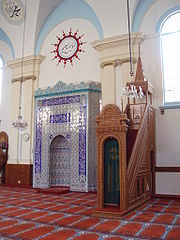
Turkey
Turkey , known officially as the Republic of Turkey , is a Eurasian country located in Western Asia and in East Thrace in Southeastern Europe...
that were left behind by expelled Greeks in 1923 were converted into mosques, and a number of synagogues were confiscated and converted to mosques after the expulsions of the Jews from Arab lands during the 1950s and 60's.
A relatively significant surge in church-mosque conversion followed the 1974 Turkish Invasion of Cyprus
Turkish invasion of Cyprus
The Turkish invasion of Cyprus, launched on 20 July 1974, was a Turkish military invasion in response to a Greek military junta backed coup in Cyprus...
. Many of the Orthodox churches in Northern Cyprus have been converted, and many are still in the process of becoming mosques. This practice has sparked considerable contempt in the Greek Cypriot community, and is likely to complicate reconciliation with the Turkish Cypriots.
In Iran, all holy places of the Bahá'í religion have been demolished. The House of the Báb in Shiraz
Shiraz
Shiraz may refer to:* Shiraz, Iran, a city in Iran* Shiraz County, an administrative subdivision of Iran* Vosketap, Armenia, formerly called ShirazPeople:* Hovhannes Shiraz, Armenian poet* Ara Shiraz, Armenian sculptor...
was turned to rubble in 1979, soon after the Islamic Revolution, and a mosque dedicated to the Imam Mahdi
Muhammad al-Mahdi
Muḥammad ibn al-Ḥasan al-Mahdī is believed by Twelver Shī‘a Muslims to be the Mahdī, an ultimate savior of humankind and the final Imām of the Twelve Imams...
was built on the site.
The defunct Hagia Sophia Church in İznik
Iznik
İznik is a city in Turkey which is primarily known as the site of the First and Second Councils of Nicaea, the first and seventh Ecumenical councils in the early history of the Church, the Nicene Creed, and as the capital city of the Empire of Nicaea...
(ancient Nicaea) was re-converted into a mosque on the Eid al-Adha of 2011. The prayer session was attended by the ruling AK Parti
Justice and Development Party (Turkey)
The Justice and Development Party , abbreviated JDP in English and AK PARTİ or AKP in Turkish, is a centre-right political party in Turkey. The party is the largest in Turkey, with 327 members of parliament...
deputies as well as an immense Muslim congregation.
Churches and synagogues in non-Islamic countries re-arranged as mosques
In areas that have experienced Islamic immigration, such as parts of Europe and North America, some church buildings, and those of other religious congregations, that have fallen into disuse have been converted into mosques following a sale of the property.In London
London
London is the capital city of :England and the :United Kingdom, the largest metropolitan area in the United Kingdom, and the largest urban zone in the European Union by most measures. Located on the River Thames, London has been a major settlement for two millennia, its history going back to its...
, the Brick Lane Mosque
Brick Lane Mosque
Brick Lane Jamme Masjid formerly known as the London Jamme Masjid , is located in the area of Spitalfields alongside the street of Brick Lane and Fournier Street in east London, England...
has previously served as a French Protestant
Huguenot
The Huguenots were members of the Protestant Reformed Church of France during the 16th and 17th centuries. Since the 17th century, people who formerly would have been called Huguenots have instead simply been called French Protestants, a title suggested by their German co-religionists, the...
chapel and a synagogue.
See also
- Buddhas of BamiyanBuddhas of BamiyanThe Buddhas of Bamiyan were two 6th century monumental statues of standing buddhas carved into the side of a cliff in the Bamyan valley in the Hazarajat region of central Afghanistan, situated northwest of Kabul at an altitude of 2,500 meters...
- Islam and other religionsIslam and other religionsOver the centuries of Islamic history, Muslim rulers, Islamic scholars, and ordinary Muslims have held many different attitudes towards other religions...
- The Conversion of non-Christian places of worship into Churches

